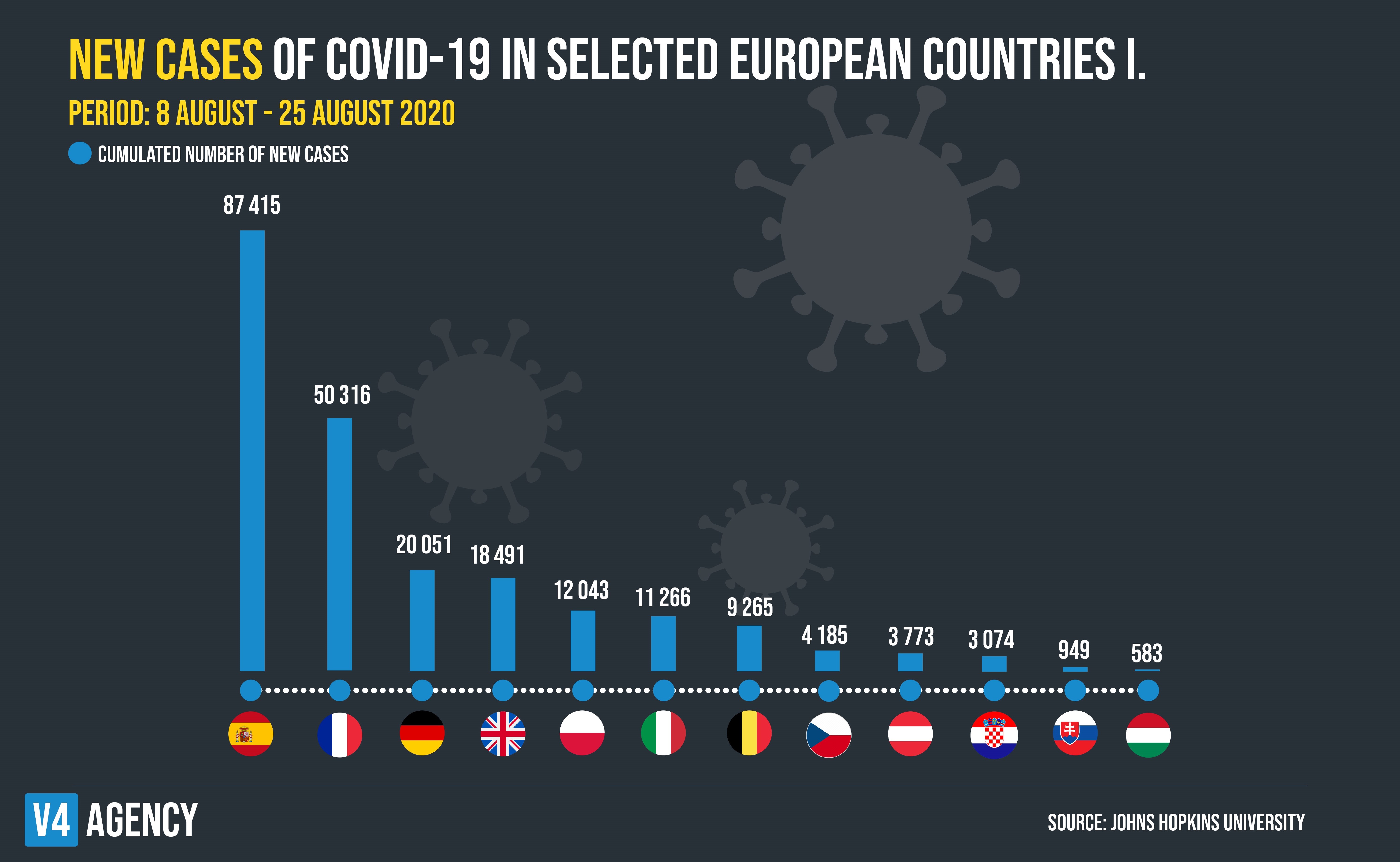
V4NA overview: All hell breaks loose in Spain
As the epidemiological situation is deteriorating in most European countries, stricter rules are expected from 1 September. V4NA s overview shows which are the countries that are still considered safe, and which ones are struggling the most with the novel coronavirus disease.
Spain has over 386,000 coronavirus infections, the highest number in Europe, and the disease has claimed over 28,000 lives so far. After a relative stagnation in the May-June period, the number of infections began to rise sharply again from the end of July, and the daily infection numbers also reached into the thousands. Following July s stagnation, the darkest day was 11 August, when health authorities registered 6,015 new Covid-19 cases. The death toll also appears to be rising with two outstanding days during the last three weeks: there were 73 deaths on 10 August while 127 died on 19 August.

Spain and its islands – such as Ibiza, Marbella and Mallorca – are popular holiday destinations for many Europeans. However, due to a potential second wave of the virus, several member states have categorised them as red, which indicates a high risk factor. Last week Belgium placed several Spanish provinces on a blacklist, requiring returnees to take a test and self-isolate for two weeks. Britain put Spain in the yellow colour-code at the end of July, and Hungary at the beginning of August.
Coronavirus is spreading faster in Spain than in any of its neighbouring nations, despite the country initially having one of the strictest lockdowns
Why is it seeing a second spike? https://t.co/yjBGbM2MIG
— BBC News (World) (@BBCWorld) August 21, 2020
Meanwhile, experts warn that the horrific first phase of the coronavirus, which ended in early June, could re-emerge in Spain where the pandemic is spreading increasingly rapidly, and where authorities have registered 142 infections per 100,000 inhabitants over the last two weeks. The death toll, however, has not witnessed such a drastic rise and the proportion of hospitalised patients is not outstanding, either. The virus is now spreading mainly among young people, Spain s health ministry says.
France
France is one of the worst-hit countries in terms of the coronavirus pandemic, ranking seventh in the world with 30,512 deaths. Two-thirds of the victims, 20,001 people, died in hospital, while one-third (10,516 patients) died in nursing homes. The growth rate in fatalities is still far behind the data published the height of the virus, with 23 deaths in the previous 24 hours, according to stats published by the French Institute for Public Health (Santé Publique France, SPF) on 21 August.
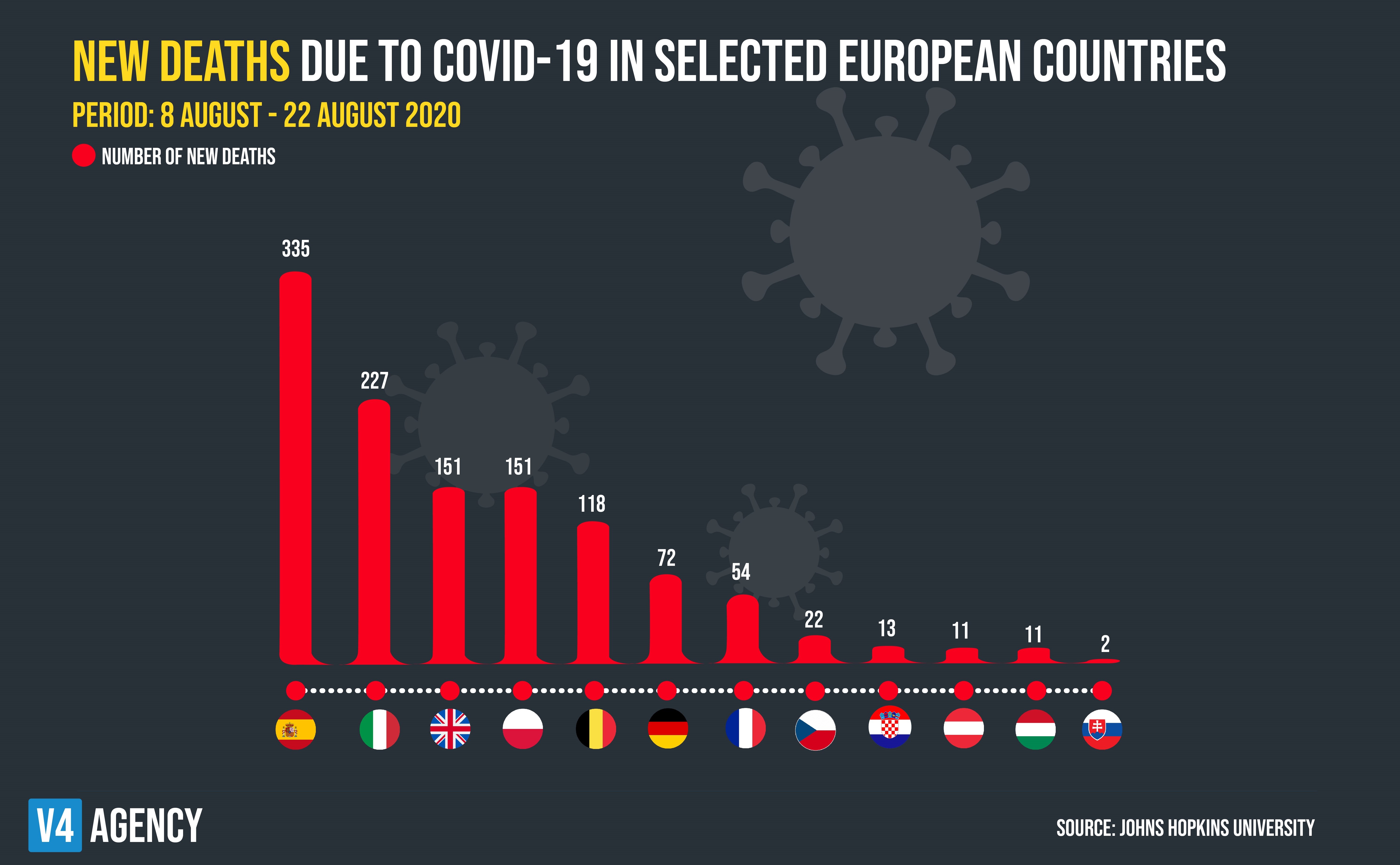
The number of new cases stagnated for a while after the easing of restrictions on 11 May, with around 3,000-4,000 new cases reported each week on average. August, however, witnessed a sharp rise in the number of cases: while health authorities registered 2,238 new patients on 18 August, they recorded 3,776 new cases – more than 1.5 times as many – on the following day. Since 20 August, the number of new patients per day has consistently exceeded 4,000, meaning the daily case numbers are higher now than they were in May. This is possibly due to the fact that the restrictive regulations were relaxed ahead of the August holidays.
???????? #FRANCE REPORTS 4,586 NEW #CORONAVIRUS CASES IN PAST 24 HOURS (v 4771 yesterday)
*Positivity Rate: 3.4% (v 3.3% yesterday).
*Santé Publique France: https://t.co/bZLT3Rguuz pic.twitter.com/v0T3IGtCvF— Christophe Barraud (@C_Barraud) August 21, 2020
The virus in France has had an impact on all age groups, but the most significant increase in infections was registered among young adults under 40. The number exceeds the 10 per 100 000 inhabitants threshold in over half of the French departements, while the situation is particularly worrying in six departements. In these, the number of new infections per 100 thousand inhabitants has exceeded 50. There are a total of 283 Covid focal points and 238,002 infected people in the country, of which 122,540 are active cases.
Italy
In Italy, the number of Covid-19 infections has seen a steady rise for the third week in a row, according to the Ministry of Health and the Italian National Institute of Health (Istituto Superiore di Sanita, ISS), which examined the period of 10-16 August. During the past two weeks, the coronavirus has been detected in an average of 9.65 people per 100,000 inhabitants. The last time the epidemic reached such critical levels was in June, when 28.3 per cent of new cases diagnosed during the week of the observation were imported by holidaymakers returning from abroad, the publication notes.
É online il di sorveglianza integrata del ???? #covid19. Tra 3 e 16 agosto :
il 63,8% dei casi trovato con contact tracing e screening
779 casi in italiani di ritorno dall estero, solo il 27,2% del totale️
Leggi il rapporto ↩️https://t.co/MDbvxkyMT2 pic.twitter.com/FeuxThyCJt— ISS (@istsupsan) August 22, 2020
The report points out that in the second wave of the virus, the average age of those infected has dropped to 30 from the previous 35 years. Thus, the dynamics of the spread of the virus are changing: “cases and outbreaks related to recreational activities appear both in Italy and abroad”. However, it can also be seen that clinical cases are less severe and those infected are asymptomatic in most of the cases. Italy currently has over 258,000 Covid-19 infections and more than 35,000 deaths, preceded in Europe only by the UK, where the disease had even more fatalities.
Due to the exceptionally high number of new infections and deaths in Spain and France, the graph below shows European cases, excluding those countries.
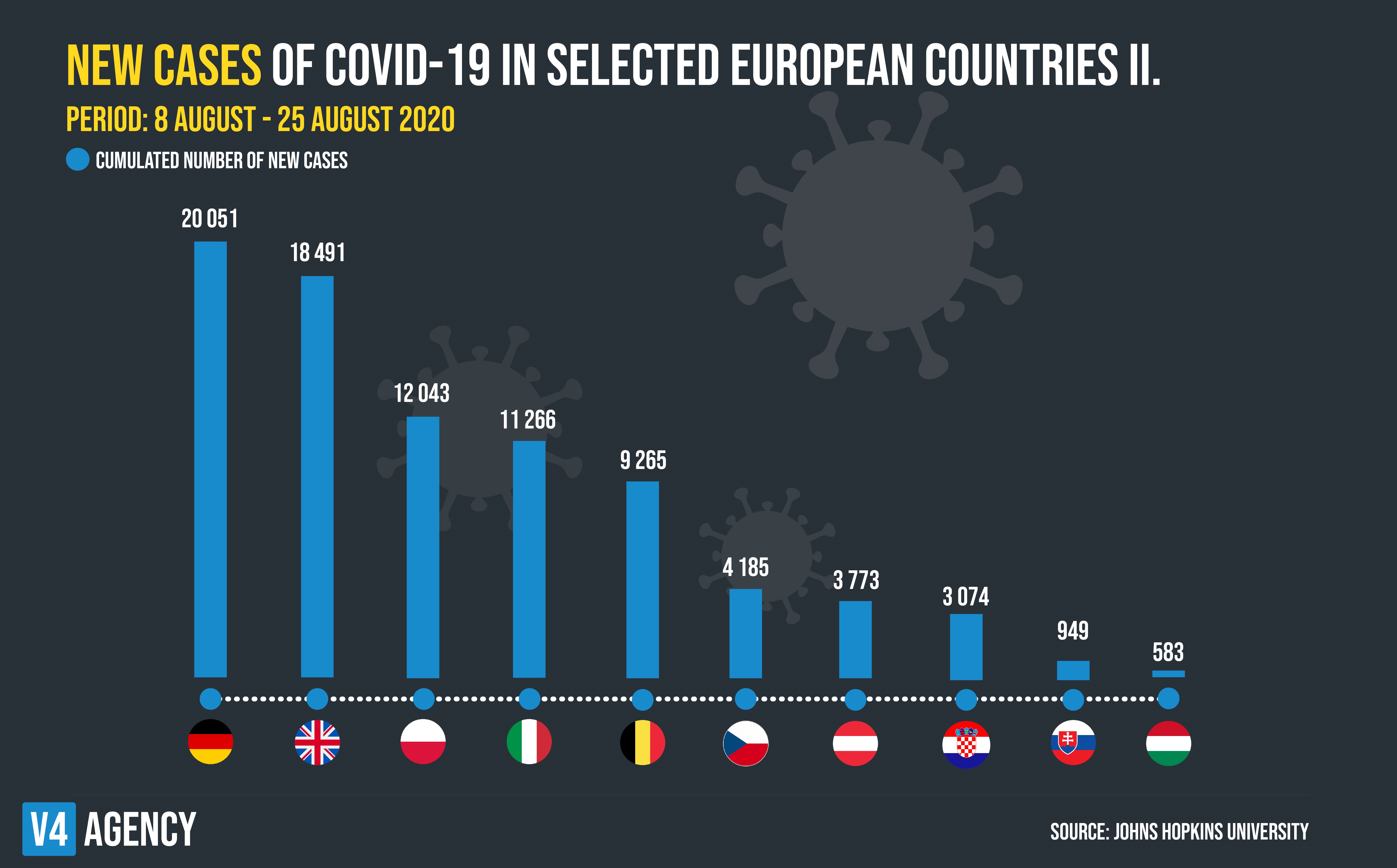
United Kingdom
The UK is preparing for a second wave of the pandemic. The death toll reached 41,000 in mid-July, but has remained stagnant ever since. The government is getting ready for a worst-case scenario as the second wave is expected by the end of December, just in time for Brexit. According to a recently leaked internal report, the economic difficulties expected during the second wave of the virus could make the country s pandemic response even more harder to endure, with possible power cuts and even riots in some places, as envisioned by the online edition of The Sun.
British authorities have put severe restrictions in place, and the relaxation of rules has led to catastrophic results in most cases. There were 30 Cocid-19 outbreaks in English schools after they reopened following the end of the lockdown, according to several analyses. A new report published by Public Health England (PHE) found that there had been 198 confirmed cases of infection linked to schools during June, with 70 among children. Boris Johnson announced in early August that the spreading of the virus had changed, and young people were becoming infected at a higher rate. However, as the virus still does not pose a serious threat to children, the government s official position is that closing schools would do more harm than a possible surge in infections. Public Health Wales incident director Dr Robin Howe said: „I think it is a concern that we are seeing an increase in cases … It is good that we are identifying them and the Test Trace Protect scheme is kicking in and bringing those cases under control and making sure that all contacts are identified and isolated.”
Belgium
The Belgian government s emergency response to the novel coronavirus is generally viewed as a failure. The country ranks second in the world in terms of deaths per million people (861) and the number of fatalities has reached 9,988 since the pandemic broke out. Of the deceased, 4,923 people died of the virus in hospitals and 4,943 people in nursing homes. Hundreds of new cases have been registered each day since the end of July, and the number of new infections in both the first and second weeks of August was over 4,100 per week. However, data recorded between 13-19 August shows a slight decrease with only 3,555 new cases reported during that period.
Le nombre d hospitalisations et de décès est en augmentation https://t.co/sYYzn0JzKQ
Het aantal ziekenhuisopnames en overlijdens stijgt https://t.co/QTOCAxZkpz#COVID19 #COVID19be pic.twitter.com/BQdbBb8SQX
— Sciensano (@sciensano) August 18, 2020
Although the number of new cases is in decline, there s a visible upward trend in the number of covid-related fatalities. While an average of 4.3 people died of coronavirus in the first week of August (from 1-7), the number of weekly victims doubled to 8.6 during the second week (from 8-14 August), and the number of hospitalised patients also rose by 13 per cent. According to the Belgian Public Health Office (Sciensano), the third week of August (from 13-19) saw an average of 9.7 people die of the coronavirus disease each day, up a 31 per from the previous period.
Belgium currently has a total of 81,468 registered virus infections and 53,276 active cases. The most infected regions are Brussels and its outskirts and Antwerp. Here, the number of new diseases grew so dractically at end of July that the government was forced to introduce a night curfew. The measure appears to have been successful because the number of new infections has dropped by 34 per cent in the last two weeks in Antwerp, Belgium s the second largest city. The situation, however, is different in Brussels, where health authorities have recorded a 9% increase.
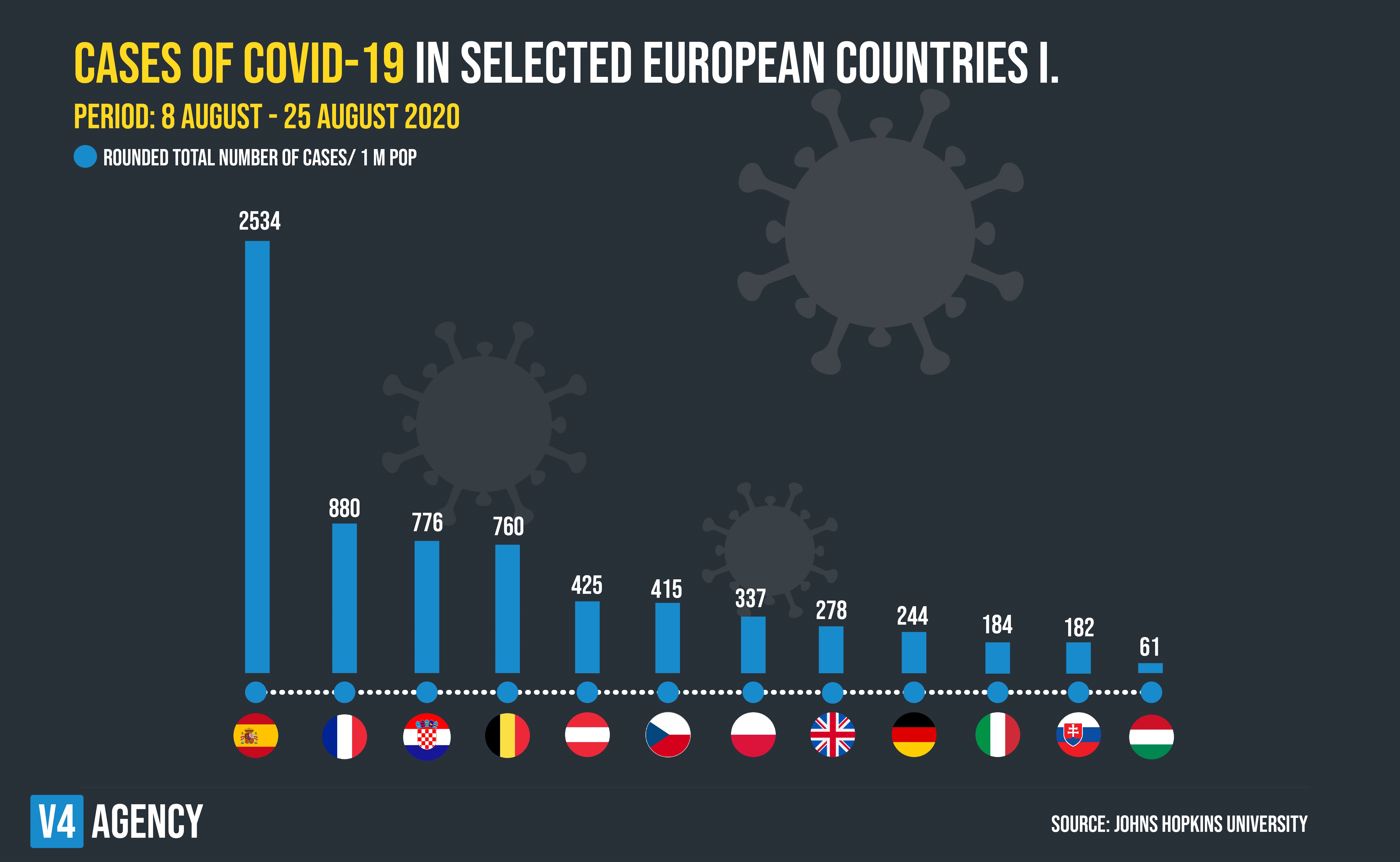
Germany
On Saturday morning more than 2,000 new coronavirus cases were reported by the Robert Koch Institute (RKI), which monitors the epidemic in Germany. It is the highest figure since April. The German health authorities reported 2,034 new cases, bringing the total number of infections to over 233,000. The number of fatalities (9,273), on the other hand, is quite low compared to other European countries, with only 11 victims per 100 thousand inhabitants. The same figure is 62 in Britain and Spain, 59 in Italy and 46 in France.
#IWF-Chefin sieht in #Corona-Pandemie die „dunkelste Stunde der Menschheit” + #Schäuble gegen #Coronabonds + Mehr als 6000 neue Fälle in Deutschland + Die Entwicklungen zur #Coronavirus–#Pandemie im Newsblog: https://t.co/b5Mgc4zk0A
— Tagesspiegel (@Tagesspiegel) April 4, 2020
RKI says the rising case numbers cannot be entirely explained by the growing number of tests. Germany has witnessed the emergence of over twenty epidemic hotspots, typically because of large social gatherings including friends and family, as well as those – typically under 35 years of age – who returned home after their holidays from Spain and Croatia. In Germany, the number of daily infections peaked in late March and early April, when more than 6,000 new cases were registered. Afterwards the figure gradually decreased, but it began to rise again at the end of July.
Austria
Austria is to update the traffic light indicator of the level of infections starting from 4 September, Health Minister Rudolf Anschober has said, adding that the colour codes of districts, cities and even federal states could change from green to orange, for example. The necessary changes will be proposed by the Coronavirus Committee, and implemented after the health minister s approval.
Auch @WHO_Europe Generaldirektor @Hans_kluge warnt vor steigenden Infektionszahlen bei Jugendlichen & jungen Erwachsenen. Wir alle sehnen uns nach Normalität & einem unbeschwerten Sommer. Damit wir gut durch Herbst & Winter kommen, müssen wir zusammenhalten. https://t.co/eW4iF9mX0E
— Rudi Anschober (@rudi_anschober) August 21, 2020
In Austria the number of Covid-19 infections has been increasing by around 140-300 people a day during the last two weeks. The number of new infections exceeded 300 from Friday to Saturday, with 191 new cases reported on Sunday. Speakig to the Saturday night news programme of Austria s public ORF TV, Rudolf Anschober expressed his concerns that the reproduction rate of the virus had reached 1.3, the highest value since the beginning of May. He said 42 per cent of new patients have been infected by family members and 22 per cent have contracted the virus at various social events (such as weddings, birthday parties, or baptisms), while 25 per cent became infected during their holidays abroad, typically in Croatia.
The graph below shows the number of illnesses per 1 million inhabitants in European countries in the last two weeks, excluding Spain s figures that are extremely high.
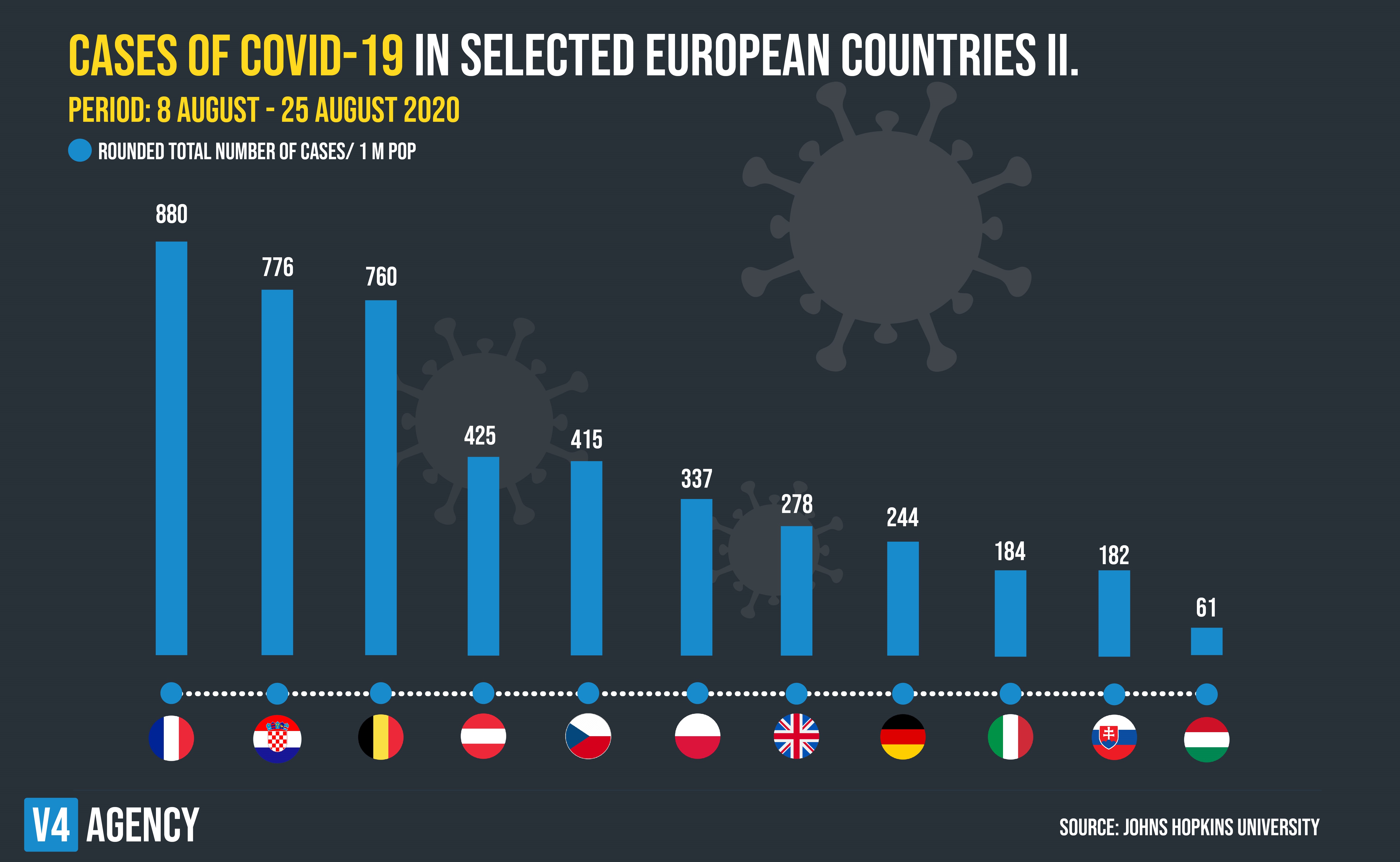
The Czech Republic
Infection figures in the Czech Republic have been rising steadily last week and the number of new cases exceeded 300 four times in August so far. The situation peaked on 21 August, when health authorities registered 506 new coronavirus infections, the highest figure since March. The number peaked on 27 March with 377 illnesses. According to the Czech health ministry, the increase can be explained by the fact that the government has intensified testing at the country s 12 virus hotspots. The Czech Republic has registered over 21 thousand infections, while the number of active infections is 5,200. The disease claimed 411 lives, and more than twenty patients are in intensive care units. The wearing of face masks on public transport, at bus and train stations and indoor public spaces will be mandatory starting from 1 September.
Slovakia
In Slovakia, the number of registered coronavirus infections has been on the rise again since the end of July. The country currently has 3,316 registered infections with 1,136 active cases. Slovakia s death toll figures have remained extremely low during the first wave of the Covid-19 in the spring, and in fact no new fatalities were registered between mid-May and 31 July. The trend, however, appears to be changing as the country witnessed 3 days since the end of July when the disease has claimed the lives of local citizens.
The Central European country recorded the highest daily number of cases on 21 August (123). The rise suggests that the second wave of the epidemic has set in, according to Slovak Health Minister Marek Krajci. The school year in Slovakia will start on 1 September according to schedule, but students will be required to wear masks until at least the 15th of September. In addition, parents must submit written statements declaring whether or not their children are infected, and if a student is absent from school for more than three days, a declaration must be repeated.
Poland
In Poland, the number of coronavirus infections has been rising since the end of July, with the number of new registered patients staying firmly above 500 throughout August. The number of infections reached a record high as more than 900 new cases were registered both on Saturday and Sunday.
Mamy 581 nowych i potwierdzonych przypadków zakażenia #koronawirus z województw: małopolskiego (98), śląskiego (97), pomorskiego (86), łódzkiego (67), mazowieckiego (49), wielkopolskiego (46), podkarpackiego (45), warmińsko-mazurskiego (25), dolnośląskiego (24), lubelskiego (12),
— Ministerstwo Zdrowia (@MZ_GOV_PL) August 23, 2020
The total number of virus infections is over 62 thousand, out of which the number of active cases currently exceeds 17 thousand. The death toll is close to 2,000. Poland experienced a downward trend in terms of the number of active infections until mid-July, but figures have since begun to rise sharply again.
Hungary
In Hungary, the number of registered coronavirus cases has increased by 24 in just one day by Tuesday, to 5,215 in total. An elderly patient with a chronic underlying illness died, bringing the number of deaths to 614, while 3,716 patients have made a recovery, according to the official koronavirus.gov.hu portal. The number of active infections in Hungary is 885, which is the lowest in the region, and much milder than the same figure in Western European countries.
#Hungary has gone up by 22 to 5,155 infections over the past 24 hours. #Hungarian #COVID #coronavirus #health #healthcaresystem… – https://t.co/XgXbVFGrmN
— Daily News Hungary (@DNewsHungary) August 23, 2020
Hungary is planning to introduce new, tougher restrictions from 1 September, Prime Minister Viktor Orban told Hungary s public radio during his regular Friday morning interview. He emphasized that the situation is deteriorating in most European countries and the possible import of the virus is a major concern for Hungary. The country is contemplating a defence mechanism different from the traffic light system applied by many European countries. „We can no longer maintain this method of allowing entry into the country and stricter rules may be needed. No one should book or organise holidays in south European countries from September,” the prime minister said.

Regarding the Western Balkan states, including Serbia, Kosovo, northern Macedonia, Bosnia-Herzegovina and Montenegro, the number of confirmed Covid-19 infections rose by 852 in just one day, from Saturday to Sunday. The death toll also rose to 695 in Serbia, 457 in Kosovo, 563 in North Macedonia, and to 531 in Bosnia-Herzegovina.
Croatia
For the fourth consecutive day, the number of new coronavirus cases reached a new spike, exceeding 300 in Croatia on Saturday. By Tuesday morning, the number of infections grew by another 219, bringing the total number of cases to more than 8500, according to Croatia s coronavirus task force. One patient died, raising the pandemic-related death toll to 175. 167 patients are in intensive care units, and nine patients are on ventilators. The number of active cases is 2231, the highest since the onset of the epidemic.
O največ na novo odkritih primerov poročajo iz Splitsko-dalmatinske županije (66), sledi Zagreb s 47 okužbami, nato pa Šibensko-kninska (24) in Zadrska (20) županija. https://t.co/CMNH8SDlj3
— 24ur.com (@24ur_com) August 19, 2020
The highest number of new cases was registered in the capital, Zagreb and Split-Dalmatia county with 53 and 92 infections respectively, including nine foreign nationals who tested positive for the virus. The task force managing the crisis tightened restrictions in Split-Dalmatia county. Bars and restaurants can only serve their customers in outside courtyards, gardens or patios. Weddings and funerals can only be attended by crowds of up to 50, while attendance at private gatherings is capped at twenty people. The measures are in force for two weeks, but Health Minister Vili Beros said restrictions may remain in place longer if needed.

